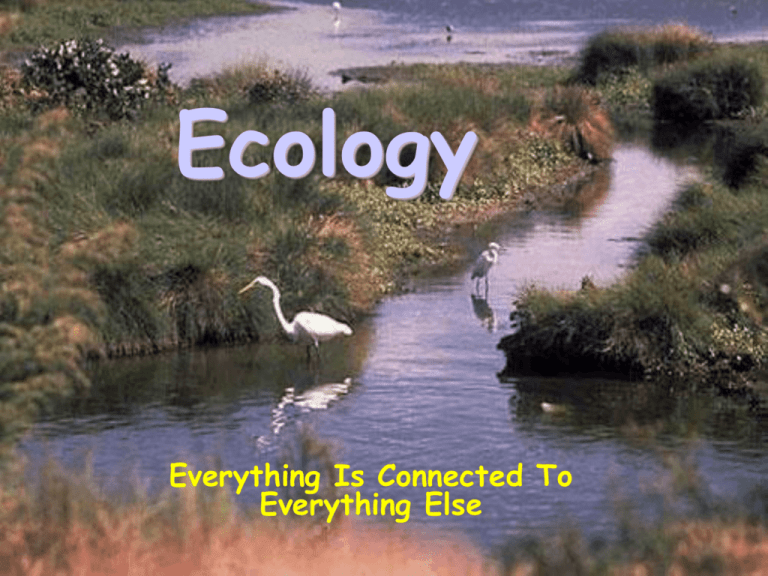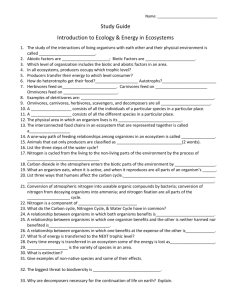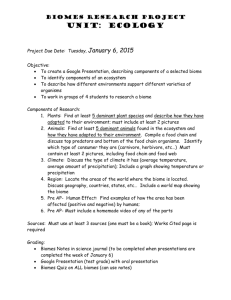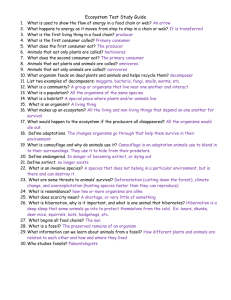Ecology Presentation
advertisement

Ecology Everything Is Connected To Everything Else What is Ecology? • Ecology is the study of the relationships and interactions of living things with one another and with their environment. What is the Environment? • The environment includes all living and nonliving things that surround an organism. Biotic vs Abiotic • Biotic includes all living things in the environment. – Examples: plants, animals, insects, protists, fungi, bacteria, etc. • Abiotic includes all nonliving things in the environment. – Examples: light, temperature, wind, rocks, soil. Is Water Biotic or Abiotic? • Water itself is abiotic. – Water contains many life forms – Water is the one thing required by all living things. What is an Ecosystem? • Scientists divide the world into separate ecosystems. – Example: a forest ecosystem • An ecosystem is an area in which living things and nonliving things interact, exchanging energy and materials. What is a Community? • A community is the living part of any ecosystem - all the different organisms that live together in that area. All the living things in an area form a community What is a Population? • Each kind of living thing makes up a population in the community. • A population is a group of organisms of the same species living together in the same area. Sea anemone population Gopher mounds What is a Habitat? • A habitat is the specific place in which an organism lives. – A habitat provides food, shelter, and the other resources an organism needs to survive. – Different organisms live in different habitats because they have different needs. Ant population in its habitat Egret population in its habitat with its community Limiting factors Energy Roles in the Environment • Organisms can be producers, consumers or decomposers. – These roles indicate how an organism gets its energy and how it interacts with other living things in the community. Energy Roles in the Environment What is a Producer? • A producer is the source of all the food in an ecosystem. – Producers are able to take a source of energy, (such as sunlight), to turn raw materials, (such as water and carbon dioxide), into energy. – Examples are green plants and certain microorganisms. What is a Consumer? • A consumer is an organism that feeds directly or indirectly on producers. – There are many kinds of consumers: • Herbivores • Carnivores • Omnivores • Scavengers Herbivores • Herbivores are consumers that feed on plants. – Examples are grasshoppers and rabbits Herbivores Herbivores Carnivores • Carnivores are consumers that feed on other animals. – Examples are spiders, snakes, wolves. Carnivores Carnivorous Plants Omnivores • Omnivores are consumers that feed on both plants and other animals. – Examples are humans, crows, bears. Omnivores Scavengers • Scavengers are animals that feed on the bodies of dead animals. • Examples are vultures, jackals, hyenas. More Scavengers What is a Decomposer? • Decomposers are organisms that break down dead organisms into simpler substances. • Examples are mold, mushrooms, bacteria. Food Chains and Food Webs • The food and energy links among producers and consumers in an ecosystem are represented by food chains and food webs. Food Chain • A food chain represents a series of events in which food and energy are transferred from one organism in an ecosystem to another. – The first link in a food chain is always a producer. – The second link is a herbivore. – The third link, and all the links after that, are almost always carnivores. – The “end” of a food chain is always connected to the “beginning” by decomposers. Food Web • Since there are many organisms in an ecosystem, and few that eat only one kind of food, there must be more than one food chain in an ecosystem. • A food web consists of many overlapping food chains. – Food webs give the whole picture of the food and energy relationships in an ecosystem. What is a Niche? • Every organism has a niche in life. • A niche is the role an organism has in an ecosystem. – Niche is “what the organism does” – An organisms niche includes: the place it lives; the food it eats; the organisms that feed on it, interact with it; the amount of light, humidity and other physical conditions it needs to survive. Interaction Among Living Things • Ecosystems involve many interactions between organisms. • Each organism in a community has its own unique role to play. This role, or niche, is more than just the organisms place in the food web. Competition is Interaction Competition vs Interaction • Because the resources (food, water, shelter, light etc.) of an ecosystem are limited, it can not satisfy the needs of all the organisms living in it. • Competition is the interaction, or struggle, of organisms against each other to get the things they need to survive. Plant Competition Animal Competition Predation is Interaction • Predators are living things that catch, kill, and eat other living things. – Examples: cats, hawks, snakes. • Prey are the organisms that are eaten by predators. – Examples: mice, • Predation plays an important role in shaping the structure of a community. Some Predators Symbiosis is Interaction • Symbiosis is the close relationship between two organisms in which at least one organism benefits. • In symbiosis one organism lives near, on, or even inside, another organism. 3 Categories of Symbiotic Relationships • Symbioses are placed into three categories: – Commensalism – Mutualism – Parasitism Commensalism • In commensalism, one of the organisms benefits and the other is not harmed by the relationship. – Example: Sparrows and wrens set up their nests below an osprey nest for protection from enemies. Examples of Commensalism Mutualism • In mutualism, both organisms benefit from the relationship. – Example: Ants “herd” aphids. Aphids get fresh leaves for food and the ants get the sugary secretion from the aphids. – Example: Shrimp and gobi fish. Blind shrimp gets “eyes”, gobi gets a home. – Example: Microorganisms get a home and help partner in some way (digestion). Mutualism • In mutualism, both organisms benefit from the relationship. – Example: Ants “herd” aphids. Aphids get fresh leaves for food and the ants get the sugary secretion from the aphids. Examples of Mutualsim – Example: Shrimp and gobi fish. Blind shrimp gets “eyes”, gobi gets a home. – Example: Microorganisms get a home and help partner in some way (digestion). Mutualism at Work Parasitism • In parasitism, one organism benefits and the other organism is harmed. – Example: ticks, fleas, mosquitos, leeches all feed on another organism, a host, that experiences some harm. – Example: Disease-causing worms, bacteria and viruses are internal parasites. Some Parasites Parasite and Effects Parasite vs Host • In parasitism, a parasite usually lives on or in a much larger organism and feeds on it while it is still alive. • The parasites unlucky partner is called the host. • Parasites do not usually kill their host, but many do weaken it greatly. Parasite and Host Cycles in Nature Time • Cycles in nature often occur in a regular rhythm, or time pattern. What is Rhythm? • A rhythm is any pattern that occurs over and over again. • Many biological rhythms are often in harmony with natural cycles. – Daily rhythms – Lunar rhythms – Annual rhythms Daily Rhythms • Diurnal organisms are those that are active during the day. • Nocturnal organisms are those that are active during the night. Lunar Rhythms • Lunar rhythms are rhythms that are controlled by the moon, such as the rise and fall of the tides. What are Biological Clocks? • Biological clocks are internal timers that may be responsible for keeping track of many different cycles of time. Why Have Biological Clocks? • Biological clocks help organisms survive. • Biological clocks help living things stay in step with rhythmic cycles of change in their environment. – When the time is right, biological clocks tell organisms to change their appearance, behavior, or body functions in some way. Cycles in Nature – Annual Rhythms • Many natural rhythms are closely associated with the seasons of the year. • Annual rhythms are events that occur once a year. – There are many examples of annual rhythms such as migration, hibernation and estivation. Cycles in Nature - Migration • Migrations are annual rhythms in which organisms travel from the place where they breed to the place where they feed. Why Migrate? – Organisms migrate to find more beneficial environments as seasonal changes make their old environment less habitable. – Examples: Geese, turtles, whales, salmon Migration Patterns Cycles in Nature - Hibernation • Some organisms avoid unfavorable seasonal changes by “sleeping” through the bad periods of the year. • During this “sleep” the body functions of the animal slows down. • This enables animals to wait out the bad periods of the year in a sheltered hiding place. What is Hibernation? • Hibernation is the winter resting, “sleeping”, state for organisms avoiding the cold, harsh winter months. – Examples: bears, toads. Hibernating Boar What is Estivation • Estivation is the summer resting, “sleeping” state for organisms avoiding the hot, dry, harsh summer months. – Example: African lungfish buries itself in the mud at the bottom of the lake before it dries out. These fish can survive for years in their shell of dried mud. Estivation Cycles of Matter • Matter can not be created or destroyed. • Matter, in the form of chemicals, flows in cycles from the nonliving part of the environment to living things and back again. 4 Important Matter Cycles • Hydrologic (Water) Cycle • Carbon Cycle • Oxygen Cycle • Nitrogen Cycle The Water Cycle Water Cycle Terms • Radiation is the suns energy (heating water). • Evaporation is water (liquid) changing to water vapor (gas). Evaporation requires energy. • Condensation is water vapor (gas) changing to water (liquid). Condensation releases energy. • Precipitation is any form of water falling from the sky. • Infiltration/Percolation is water filtering into the ground. • Runoff is water that flows on top of the ground. • Perspiration is water that comes out of animals in the form of sweat. Respiration is from breathing. • Transpiration is water that comes out of plants. The Oxygen and Carbon Cycles • Carbon dioxide is used by producers such as green plants. • Oxygen is released by producers such as green plants. • Oxygen is used by air-breathing organisms. • Carbon dioxide is released by airbreathing organisms. Two Carbon Cycles The Nitrogen Cycle • All living things need nitrogen but most organisms can not get enough from the air. • Nitrogen fixation by bacteria use free nitrogen in the air to make nitrogen compounds called nitrates. • Plants use the nitrates to make compounds called proteins. • Other organisms that can not use nitrates directly use the proteins containing nitrogen. • Decomposers, such as bacteria, break down the complex nitrogen compounds in dead organisms and animal waste, returning simple nitrogen to the soil. • Nitrogen can go back and forth between plants and soil many times. • Eventually bacteria break down the nitrogen compounds into free nitrogen which is released into the air. Nitrogen Cycle Cycles of Change • Ecological succession is the process in which the community in a particular location is gradually replaced by another community. • Succession usually takes a long time. Primary and Secondary Succession • Primary succession is the establishment and development of communities in newly formed areas. – Such as cooled lava, rocky surfaces, and sandy areas. • Secondary succession is succession that occurs in disturbed areas. – Such as abandoned farmland, vacant lots, and cleared areas. Stages of Ecological Succession Ecological Succession When Does Succession End? • Left alone, over time, a community may consist of a group of species that are not replaced by new species. • This stable collection of plants, animals and other organisms is known as a climax community. – Examples are redwood trees in Northern California, black pines in the pine barrens, oak and hickory trees in the North Eastern U.S. Climax Communities Biogeography • Biogeography is the study of where plants and animals live throughout the world. Dispersal is the movement of living things from one place to another. Barriers to Dispersal • Natural barriers such as water, deep valleys or mountains can prevent dispersal. • Ecological barriers such as habitats that do not meet the organisms needs also prevent dispersal. – Example is the opossums move north. • Objects built by man can also be barriers to dispersal. – Examples are dams blocking salmon, highways, fences. Natural Barriers Man-made Barrier Biomes of the World • Areas of the world are characterized by their climate and the organisms living there. • Biomes are environments that are grouped by similarities in climate and ecological communities. 6 Major Land Biomes • Scientists have identified 6 major land biomes of the world: – – – – – – Tundras Coniferous forests Deciduous forests Tropical rain forests Grasslands Deserts Tundra Biomes • The climate of a tundra is very cold and dry. (Like a cold desert) – Temperatures rarely go above freezing. – Rainfall is less than 25 cm. per year • The soil there that is permanently frozen is called permafrost. • Life forms are lichens, dwarf willows, caribou, musk oxen, lemmings. Tundras Coniferous Forest Biomes • The climate here is cold but the soil thaws completely in spring forming swampy areas. • Coniferous forests are made up of trees called conifers that survive well in the poor soil of these areas. – Conifers, also known as evergreens, produce their seeds in cones. • Animals include moose, birds, beavers, lynx, weasels, and squirrels. Coniferous Forests Deciduous Forest Biomes • The climate here is warmer and there is at least 75 cm of rain per year. • Deciduous trees, such as oaks, maples, hickories and beeches, shed their leaves in autumn making the soil richer. • Animal life includes insects, spiders, worms, snails, frogs, raccoons, deer, birds, grouse, snakes, salamanders. Deciduous Forests Tropical Rain Forest Biomes • The climate here is like summer all year round and it rains almost every day (at least 200 cm. of rain per year). • Plant life is more varied than any other biome due to good soil, lots of water, and year-round growing conditions. – A canopy, or green roof where tops of trees meet, keeps the ground cool and dimly lit. • Animal life is also varied (insects, birds, snakes, monkeys, wild cats) due to abundant food supplies. Tropical Rain Forest Biomes • Most of the undiscovered species of plants, animals and insects, exist in tropical rain forest biomes. Rain Forests Grassland Biomes • The climate here is warm with low rainfall (between 25 and 75 cm. yearly). • Africa has the largest grasslands in the world. • Grasses are the main group of plants accompanied by few, thorny trees called acacias. Wildfires often prevent tree growth. • Animal life is largely herbivores such as zebra, antelope, mice, rats, also snakes, lions, cheetahs, elephants, hawks, eagles. Grasslands Desert Biomes • A desert biome is very dry (receives less than 25 cm. of rain per year) but can be either hot or cold. – Sahara Desert is hot; Gobi desert is cold. • Plant life, cactus, aloe, palm trees, survive on little water. • Animal life, such as lizards, rodents, camels, must survive on little water. Deserts Water Biomes • The two major water biomes are: – Marine biomes – Freshwater biomes Marine Biomes • The marine biome, or ocean biome, covers about 70% of the earth. • Oceans are divided into different zones based on sunlight, temperature, pressure, and currents with different organisms in each. • Organisms living here have adapted to be able to survive in salt water. • Phytoplankton are microscopic plants that live near the surface. Almost all animals in the oceans depend directly or indirectly on these plants. Freshwater Biomes • The freshwater biome includes both still water (ponds and lakes) and running water (rivers and streams). • There are factors that affect the life in freshwater biomes: – – – – – Temperature Sunlight Amount of oxygen Food available Speed of movement Fresh Water Biome Estuaries • An estuary is a boundary between a freshwater biome and a marine biome. • Estuaries are extremely fertile areas. – Since estuaries are shallow, sunlight reaches all levels so marsh grasses, algae and other plants live there and provide food for a variety of fishes, crabs, oysters and shrimp. • Estuaries are important as “nurseries” for many different types of young fishes. Wildlife Conservation Earth’s Natural Resources Energy Resources Earth’s Nonliving Resources Pollution Conserving Earth’s Resources







